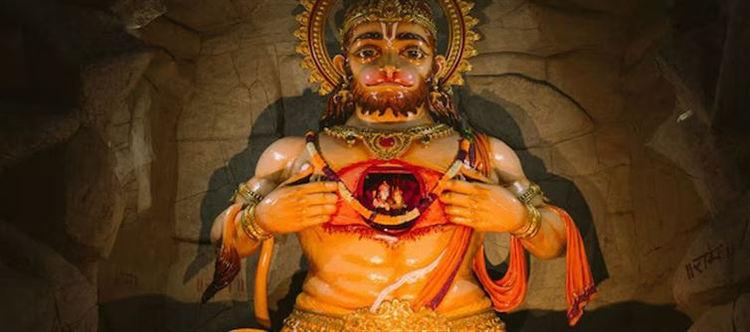
Hanuman Jayanti is a revered festival that celebrates the birth of Lord Hanuman, the mighty deity who is known for his devotion, strength, courage, and selfless service. While it is most commonly observed once a year, many people are unaware that Hanuman Jayanti is actually celebrated twice annually. Understanding the reasons behind this double celebration reveals fascinating aspects of Hindu tradition and the significance of Lord Hanuman in various contexts.
The Two Dates of Hanuman Jayanti
Hanuman Jayanti is observed on two different days depending on the region, the tradition followed, and the calendar system used. The first celebration falls on Chaitra Purnima, which is the full moon day in the month of Chaitra according to the Hindu lunar calendar. This is the more widely recognized date for Hanuman Jayanti, particularly in North india and other parts of the country. In 2025, this falls on April 12th.
The second celebration takes place on Ashvin Purnima, the full moon day in the month of Ashvin, which typically occurs around October. This date is commonly celebrated in regions like Maharashtra, Karnataka, and tamil Nadu.
Why Are There Two Dates?
The question of why Hanuman Jayanti is celebrated twice a year is deeply rooted in both astronomical and cultural practices. There are a few significant reasons:
Regional Differences in Calendar Systems: The Hindu calendar is not universally uniform. Different regions of india follow slightly different systems to mark important festivals. The northern part of india predominantly follows the Vikram Samvat calendar, which aligns Hanuman Jayanti with Chaitra Purnima. Meanwhile, other regions may use the Shaka Samvat or Drik Samvat calendar, which places the second Hanuman Jayanti during Ashvin Purnima. These variations reflect the diversity of Hindu traditions and how local customs influence religious observances.
Astrological and Religious Significance: In the Ramayana, Lord Hanuman's birth is tied to the planetary alignment and astrological factors. According to various texts, Hanuman was born on the full moon day in the month of Chaitra, under the constellation of Pushya Nakshatra. However, some texts also mention a second birth or appearance of Hanuman, hence leading to the observance of his birthday on the second full moon of Ashvin as well. This dual observance reflects the belief that Hanuman’s energy is present in two different cosmic phases of the year.
The Unification of local Traditions: As hinduism spread across india, different communities embraced Lord Hanuman in different ways. While his association with Chaitra purnima became popular in certain parts of india, others chose to celebrate the festival on Ashvin Purnima, especially in areas where the worship of Lord Hanuman was part of local traditions and deities. This dual celebration became a way of uniting people across various regions, emphasizing Hanuman's universal appeal and significance.
What Most people Don’t Know About Hanuman Jayanti
While Hanuman Jayanti is a popular festival, many of the finer aspects of its observance are not widely known. Below are some aspects of this festival that might surprise even devoted followers of Lord Hanuman
The Spiritual Power of Hanuman Jayanti: Hanuman Jayanti is not just a celebration of Lord Hanuman’s birth, but it also holds deep spiritual significance. It is believed that on this day, reciting the Hanuman Chalisa, a 40-verse devotional hymn dedicated to Lord Hanuman, can bring immense blessings and spiritual strength. Devotees believe that chanting the Hanuman Chalisa on this day removes obstacles, brings victory over enemies, and instills courage and wisdom.Celebration of Selfless Service: Lord Hanuman is often considered the epitome of selfless service and devotion. His unwavering loyalty to Lord Rama is one of the key themes of the Ramayana. Hanuman Jayanti is therefore a reminder of the importance of devotion, loyalty, and service to humanity. Many people take this opportunity to perform acts of charity, visit temples, and engage in selfless activities as a way of honoring Hanuman's teachings.A Symbol of Strength and Protection: Apart from being a symbol of devotion, Hanuman is also regarded as a protector. It is common for people to recite the Sankat Mochan Hanuman Ashtakshara Mantra or other chants dedicated to him, seeking protection from all kinds of dangers. Many devotees fast on this day, offering prayers to Lord Hanuman to safeguard them from negative influences and misfortune.Hanuman’s Dual Nature: Another lesser-known fact is that Lord Hanuman embodies both the qualities of Vairagya (renunciation) and Bhakti (devotion). His character is multi-dimensional: He is both a mighty warrior and a humble servant. Hanuman Jayanti thus encourages devotees to embrace these qualities in their lives—strength, devotion, humility, and fearlessness.The Role of Hanuman in Contemporary Times: Hanuman’s relevance continues to grow in modern-day society. In a world where many people struggle with stress, insecurity, and fear, Hanuman is often invoked as a symbol of inner strength and resilience. The Hanuman Jayanti celebrations, therefore, serve as a spiritual reminder that the qualities of courage, strength, and perseverance are within everyone.
Conclusion
Hanuman Jayanti, with its dual observances, offers a unique insight into the adaptability and diversity of Hindu religious practices. Whether celebrated in the spring or the fall, this festival serves as a powerful reminder of Lord Hanuman’s eternal presence and his lessons on strength, devotion, and selflessness. While many people are familiar with the main celebrations, the deeper significance of celebrating Hanuman Jayanti twice a year unveils a rich tradition that reflects the complexity of indian spirituality and the unwavering reverence for this divine figure.
Thus, whether on Chaitra purnima or Ashvin Purnima, Hanuman Jayanti remains a day of profound meaning, connecting the past, the present, and the future in the worship of Lord Hanuman.




 click and follow Indiaherald WhatsApp channel
click and follow Indiaherald WhatsApp channel